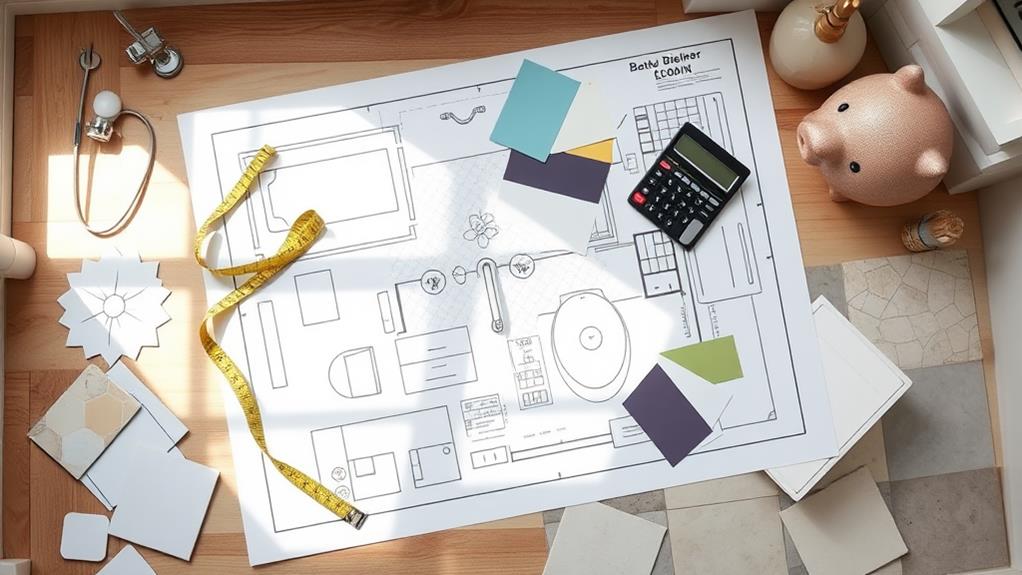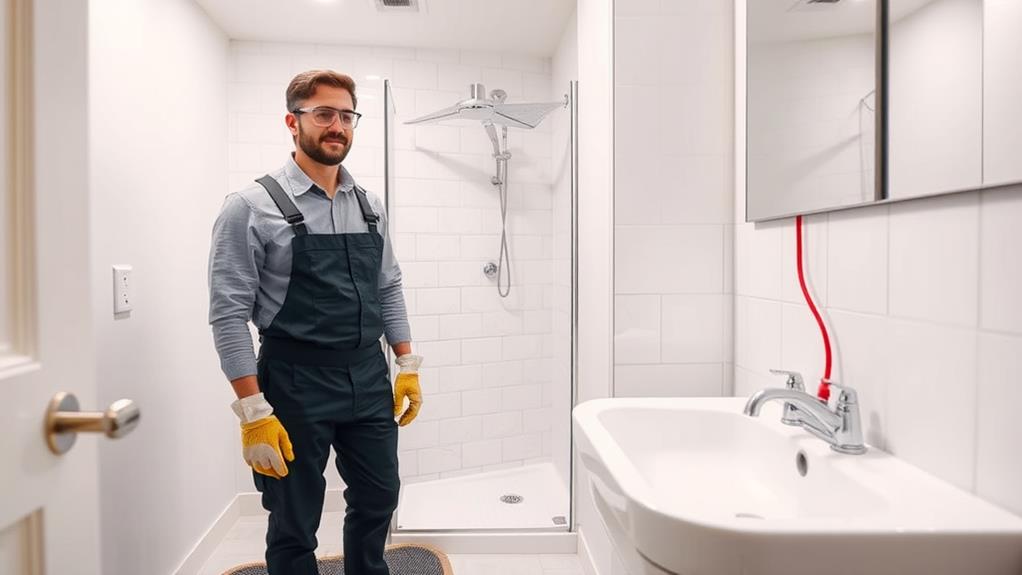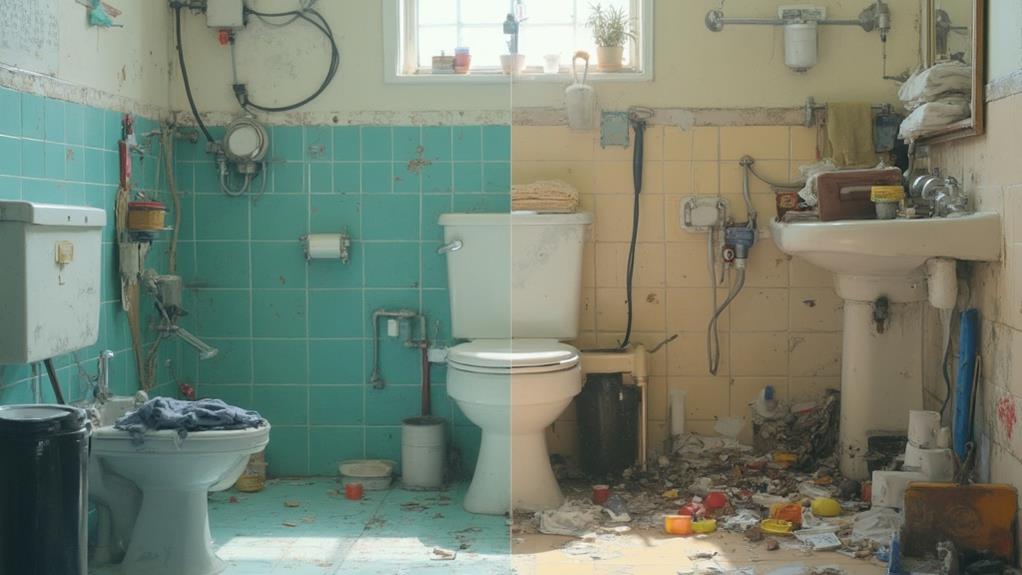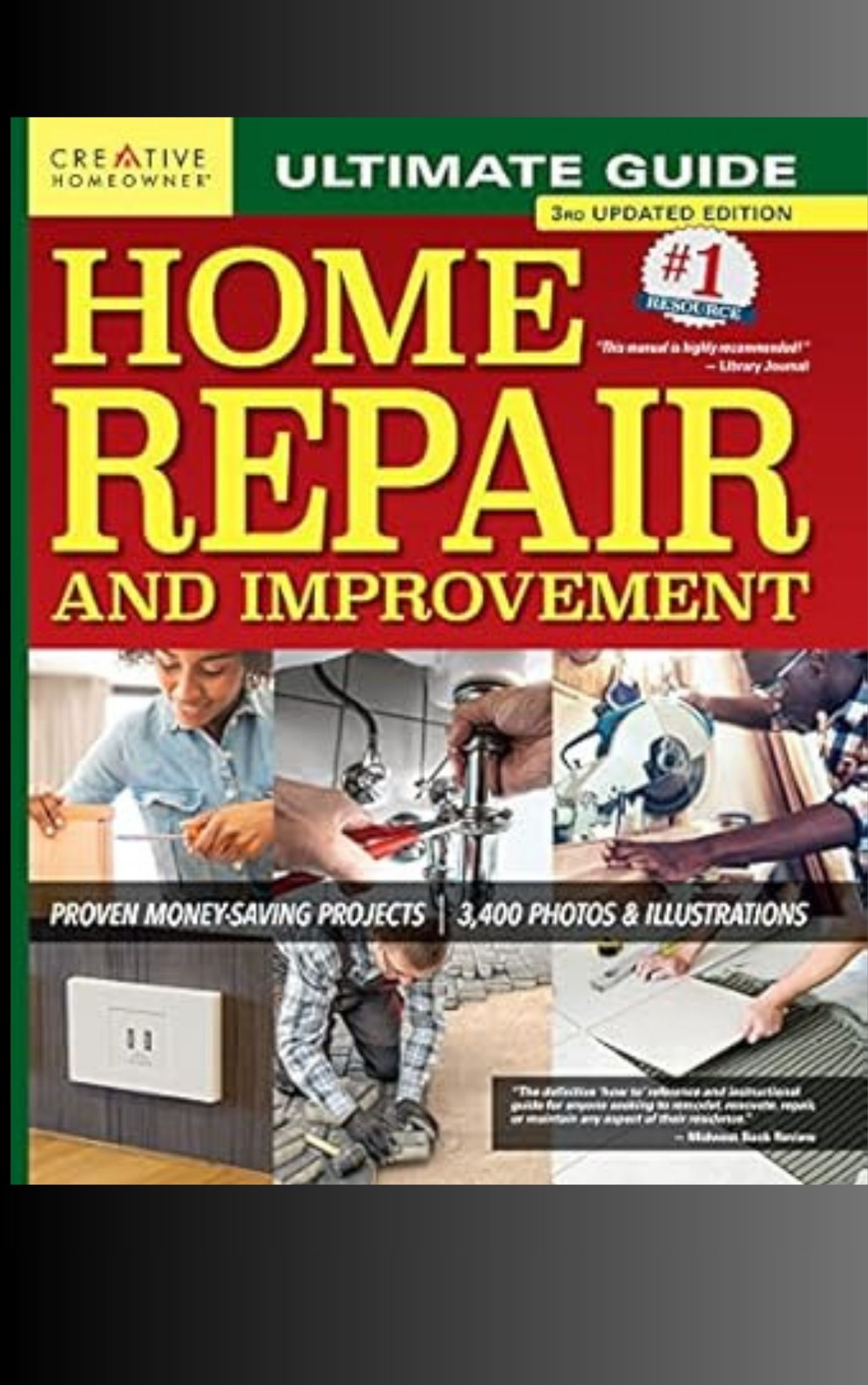When tackling a DIY bathroom renovation, do plan thoroughly, set a realistic budget with a contingency fund, and prioritize essential updates. Choose moisture-resistant materials and incorporate efficient fixtures and proper lighting. Don't underestimate the project timeline, neglect waterproofing, or overlook ventilation needs. Gather the right tools and safety gear, and familiarize yourself with local building codes. While you can handle many tasks, don't attempt complex plumbing or electrical work without proper knowledge – hire professionals when needed. By avoiding common mistakes and focusing on smart design choices, you'll create a functional and beautiful bathroom. The following tips will help you navigate your renovation with confidence.
Planning and Budgeting

The key to a successful DIY bathroom renovation lies in thorough planning and careful budgeting. Start by assessing your bathroom's current state and determining your renovation goals.
Measure the space accurately and create a detailed layout, considering the placement of fixtures, storage, and lighting. Research design ideas and make a list of must-have features versus nice-to-have elements.
Set a realistic budget by pricing materials, fixtures, and tools you'll need. Don't forget to account for unexpected expenses by adding a 10-20% contingency fund. Prioritize essential updates like plumbing or electrical work over cosmetic changes. If you're on a tight budget, consider keeping existing plumbing locations to minimize costs.
Create a timeline for your project, factoring in the time needed for each task and potential delays. Be honest about your DIY skills and decide which tasks you can handle yourself and which require professional help. Obtain necessary permits and familiarize yourself with local building codes before starting work.
Design Considerations
With your planning and budget in place, it's time to focus on design considerations for your DIY bathroom renovation. Start by assessing the room's layout and determining if any major changes are needed. Consider the placement of fixtures, ensuring they're functional and ergonomic. Don't forget to factor in proper ventilation to prevent moisture buildup and mold growth.
Choose a cohesive color scheme that complements your home's overall style. Opt for moisture-resistant materials like porcelain tiles, vinyl flooring, or waterproof paint. When selecting fixtures, prioritize water efficiency to reduce your environmental impact and lower utility bills. Consider installing a low-flow toilet, water-saving showerhead, and faucet aerators.
Lighting is crucial in bathrooms. Incorporate a mix of ambient, task, and accent lighting to create a well-lit, functional space. Don't overlook storage solutions; built-in shelves, medicine cabinets, and vanities can help maximize space and reduce clutter. If you're working with a small bathroom, use space-saving techniques like wall-mounted toilets or corner sinks. Finally, add personal touches with accessories, artwork, or plants to make the space uniquely yours.
Essential Tools and Materials

Before diving into your DIY bathroom renovation, you'll need to gather the essential tools and materials. Start with basic hand tools like a hammer, screwdrivers, pliers, and a utility knife. You'll also need measuring tools, including a tape measure, level, and square. For cutting and shaping materials, invest in a hacksaw, jigsaw, and drill with various bits.
Don't forget safety equipment such as gloves, safety glasses, and a dust mask. For plumbing work, you'll need a pipe wrench, plumber's tape, and a plunger. Electrical tasks require wire strippers, electrical tape, and a voltage tester.
Essential materials include tiles, grout, caulk, paint, and primer. You'll also need plumbing fixtures, faucets, and any new cabinets or countertops. For waterproofing, get a waterproof membrane and sealant.
Rent specialized tools like a tile saw or jackhammer if needed. Consider purchasing or renting a wet/dry vacuum for cleanup. Having these tools and materials on hand will ensure you're prepared for your bathroom renovation project, saving you time and frustration during the process.
Common Mistakes to Avoid
While enthusiasm for DIY bathroom renovations is admirable, you'll want to steer clear of common pitfalls that can derail your project. One frequent mistake is underestimating the timeline, leading to rushed work and subpar results. Always allow extra time for unexpected challenges.
Another error is neglecting proper waterproofing, which can cause extensive damage down the line. Ensure you thoroughly seal all vulnerable areas.
Don't overlook ventilation; inadequate airflow can lead to mold and mildew issues. Install a quality exhaust fan to keep moisture at bay. Many DIYers also make the mistake of choosing improper materials for a bathroom environment. Opt for moisture-resistant products specifically designed for high-humidity areas.
Poor planning of the layout is another common blunder. Consider the flow of the space and placement of fixtures before starting work. Skimping on quality to save money often backfires, resulting in frequent repairs or replacements. Invest in durable, high-quality materials for long-term satisfaction.
Lastly, don't attempt complex plumbing or electrical work without proper knowledge. These tasks are best left to professionals to ensure safety and compliance with local building codes.
Safety and Regulations

Prioritize safety when tackling DIY bathroom renovations. Always wear protective gear like safety glasses, gloves, and dust masks. Ensure proper ventilation when working with paints, adhesives, or chemicals. Turn off the main water supply and electricity to the bathroom before starting any plumbing or electrical work.
Be aware of local building codes and regulations. You'll likely need permits for major renovations, especially those involving plumbing or electrical systems. Familiarize yourself with specific requirements for bathroom renovations, such as waterproofing standards and minimum clearances for fixtures.
Don't attempt complex tasks like rewiring or moving plumbing fixtures unless you're qualified. Hire licensed professionals for these jobs to ensure compliance and safety. When installing new fixtures, follow manufacturer instructions carefully and use appropriate tools.
Consider accessibility guidelines, particularly if you're planning long-term. Install grab bars, non-slip flooring, and adequate lighting. Ensure proper ventilation to prevent mold growth and maintain air quality.
Conclusion
You've now got the knowledge to tackle your DIY bathroom renovation with confidence. Remember to plan carefully, prioritize safety, and follow regulations. Don't be afraid to seek professional help when needed. With patience and persistence, you'll create the bathroom of your dreams. Just ask Sarah, who transformed her dated 1970s bathroom into a modern oasis, increasing her home's value by $20,000. Your success story could be next!

